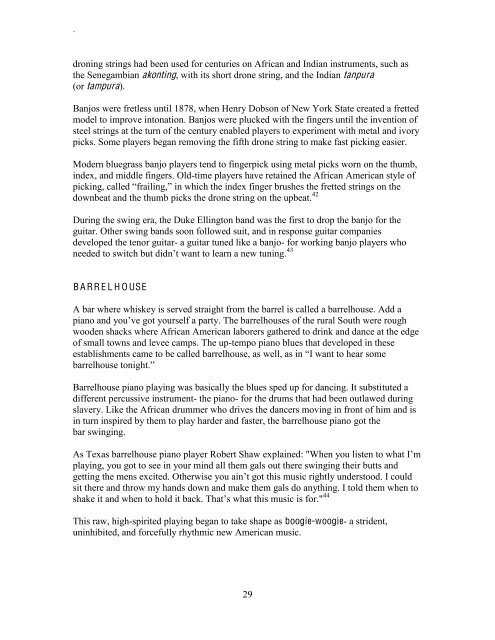Language of the Blues - Edmonton Blues Society
Language of the Blues - Edmonton Blues Society
Language of the Blues - Edmonton Blues Society
Create successful ePaper yourself
Turn your PDF publications into a flip-book with our unique Google optimized e-Paper software.
`<br />
droning strings had been used for centuries on African and Indian instruments, such as<br />
<strong>the</strong> Senegambian akonting, with its short drone string, and <strong>the</strong> Indian tanpura<br />
(or tampura).<br />
Banjos were fretless until 1878, when Henry Dobson <strong>of</strong> New York State created a fretted<br />
model to improve intonation. Banjos were plucked with <strong>the</strong> fingers until <strong>the</strong> invention <strong>of</strong><br />
steel strings at <strong>the</strong> turn <strong>of</strong> <strong>the</strong> century enabled players to experiment with metal and ivory<br />
picks. Some players began removing <strong>the</strong> fifth drone string to make fast picking easier.<br />
Modern bluegrass banjo players tend to fingerpick using metal picks worn on <strong>the</strong> thumb,<br />
index, and middle fingers. Old-time players have retained <strong>the</strong> African American style <strong>of</strong><br />
<br />
downbeat and <strong>the</strong> thumb picks <strong>the</strong> drone string on <strong>the</strong> upbeat. 42<br />
During <strong>the</strong> swing era, <strong>the</strong> Duke Ellington band was <strong>the</strong> first to drop <strong>the</strong> banjo for <strong>the</strong><br />
guitar. O<strong>the</strong>r swing bands soon followed suit, and in response guitar companies<br />
developed <strong>the</strong> tenor guitar- a guitar tuned like a banjo- for working banjo players who<br />
43<br />
<br />
B A RR E L H O USE<br />
A bar where whiskey is served straight from <strong>the</strong> barrel is called a barrelhouse. Add a<br />
<br />
wooden shacks where African American laborers ga<strong>the</strong>red to drink and dance at <strong>the</strong> edge<br />
<strong>of</strong> small towns and levee camps. The up-tempo piano blues that developed in <strong>the</strong>se<br />
<br />
<br />
Barrelhouse piano playing was basically <strong>the</strong> blues sped up for dancing. It substituted a<br />
different percussive instrument- <strong>the</strong> piano- for <strong>the</strong> drums that had been outlawed during<br />
slavery. Like <strong>the</strong> African drummer who drives <strong>the</strong> dancers moving in front <strong>of</strong> him and is<br />
in turn inspired by <strong>the</strong>m to play harder and faster, <strong>the</strong> barrelhouse piano got <strong>the</strong><br />
bar swinging.<br />
As <br />
playing, you got to see in your mind all <strong>the</strong>m gals out <strong>the</strong>re swinging <strong>the</strong>ir butts and<br />
<br />
ic rightly understood. I could<br />
sit <strong>the</strong>re and throw my hands down and make <strong>the</strong>m gals do anything. I told <strong>the</strong>m when to<br />
44<br />
<br />
This raw, high-spirited playing began to take shape as boogie-woogie- a strident,<br />
uninhibited, and forcefully rhythmic new American music.<br />
29


